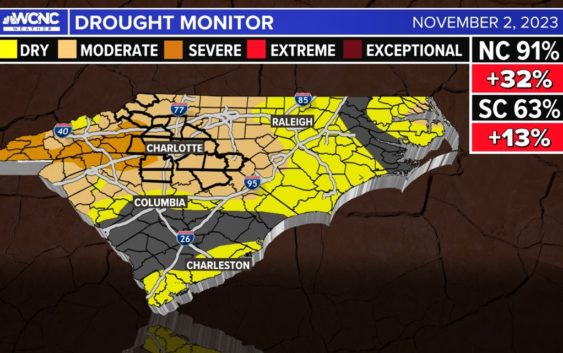- Austin leaders consider expanding wildfire protection plan
- Large hail, strong winds and tornado threat possible into Thursday evening
- Large hail, tornado threat possible Thursday evening
- Jaccob Slavin scores in OT as the Hurricanes beat the Capitals in Game 1 of their 2nd-round series
- 5 On Your Side: What happened to cars flooded during Hurricane Helene?
Fires burning in the Carolinas as drought conditions worsen

Moderate-to-severe drought will likely continue to expand over the next several weeks as a dry weather pattern remains.
CHARLOTTE, N.C. — Over 90% of North Carolina is now at least some level of drought conditions, per the U.S. Drought Monitor. This is the third consecutive fall, and the fourth in the past five years, in which parts of western North Carolina had severe drought. conditions.
Severe drought in the Carolinas
Severe drought grew to 10% for North Carolina and over 6% for South Carolina, according to the Drought Monitor, which is published weekly on Thursday in collaboration with USDA, NOAA, and others.
During a severe drought, dry conditions are growing quickly. Water conservation measures may also be implemented for consumers and water system managers, who may limit their downstream releases or otherwise operate reservoirs to hold onto more water. Such actions are already underway with Duke Energy, which uses water from the Catawba River basin, including Lake Norman and Lake Wylie, to produce electricity at their hydroelectric power plants.
Officials monitoring drought
We reached out to Linwood Peele, who supervises water supply for the North Carolina Department of Environmental Quality, to see what their thoughts were on our current drought status. Peele sent WCNC Charlotte this statement:
We’re hopeful that this drought won’t have many long-term impacts. It’s emerging just a couple months before the winter, which is usually when we see lower demand for water and evaporation, allowing lakes and streams to recharge. In addition, an El Niño pattern has historically meant wetter than normal conditions for us.
If that happens this year, it could also help wipe away recent precipitation deficits. Notably, even a winter with near-normal or even slightly below-normal rainfall, like we had each of the past two years, is typically still enough to see overall improvements in drought conditions. As we sometimes say in the drought monitoring world, a little rain goes a long way at that time of year.
Long- and short-term drought effects
Drought can cause leaves to drop early and weaken trees making them more susceptible to storm damage. Drought can also cause soil to become too dry for winter and spring crops. Most notably, drought can increase the fire danger.
For the latest weather alerts, download the WCNC Charlotte mobile app and enable push notifications.
So to overcome drought
The obvious answer is more rain but it is more complicated than that.
Winter is the best time to replenish rainfall since vegetation does not need the water as much as it does in the spring.
The general rule is slow and steady lessens the drought. A slow rain over a long period of time will soak into the water table. Too much rain too quickly can run off as flooding before the environment has time to soak it in.
WCNC Charlotte’s Weather IQ YouTube channel gives detailed explainers from the WCNC Charlotte meteorologists to help you learn and understand weather, climate and science. Watch previous stories where you can raise your Weather IQ in their YouTube playlist and subscribe to get updated when new videos are uploaded.